The Effect of Temperature and Other Factors on Plastics
This book is an update to the first edition compiled and published in 1990 by William Woishnis. A lot has changed in the field since 1990 and a lot has not changed. There are new plastic materials. There has been a huge turnover in ownership of plastics producing companies. There has been a lot of consolidation, which of course means discontinued products. Thus, this update is much more extensive than the usual "next edition."
It has been reorganized from a chemistry point of view. Plastics of similar polymer types are grouped into nine chapters. Each of these chapters includes an introduction with a brief explanation of the chemistry of the polymers used in the plastics.
An extensive first chapter has been added as an introduction that summarizes the chemistry of making polymers, the formulation of plastics, testing and test methods, and plastic selection.
Most plastic products and parts are expected to be used in environments other than room temperature and standard humidity conditions. Chapters 2-10 are a databank that serves as an evaluation of plastics as they are exposed to varying operating conditions at different temperatures, humidity, and other factors. Over 900 graphs for more than 45 generic families of plastics are contained in these chapters. The following types of graphs may also be included:
A. Properties as Functions of Temperature
(1) Flexural modulus/strength
(2) Tensile modulus/strength
(3) Shear modulus/strength
(4) Impact strength
(5) Hardness
(6) Torsional modulus
(7) Coefficient of thermal expansion
(8) Dielectric constant
(9) Dissipation factor
(10) Water absorption
(11) Specific volume/heat
(12) Pressure-volume-temperature plots
B: Stress vs. Strain Curves at Various Temperatures
(1) Strain rates
(2) Humidity levels
C: Mechanical Properties as a Function of...
(1) Strain rate
(2) Humidity level
D: Electric Properties as a Function of...
(1) Humidity level
(2) Frequency
E: Also Included
(1) Properties vs. Thickness
(2) Dimensions vs. Moisture
(3) Properties vs. Glass Content and other Formulation Factors
Chapter 11 contains extensive mechanical and electrical data in tabular form. The tables contain data on several thousand plastics. Similarly, Chapter 12 contains thermal data on several thousand plastics.
Data from the first edition have only been removed if those products were discontinued, and many products were. Product names and manufacturers have been updated.
• Detailed introductions of plastics properties, testing procedures, and principles of plastics design.
• The only "databook" available on the effects of temperature and humidity conditions on plastics and elastomers.
• More than 1,000 graphs and tables allow for easy comparison between products.
• Covers more than 70 types of plastics, and summarizes the chemistry of each type.
BISAC SUBJECT HEADINGS
TEC055000: TECHNOLOGY / Textiles & Polymers
TEC021000: TECHNOLOGY / Material Science
TEC016020: TECHNOLOGY / Industrial Design / Product
It has been reorganized from a chemistry point of view. Plastics of similar polymer types are grouped into nine chapters. Each of these chapters includes an introduction with a brief explanation of the chemistry of the polymers used in the plastics.
An extensive first chapter has been added as an introduction that summarizes the chemistry of making polymers, the formulation of plastics, testing and test methods, and plastic selection.
Most plastic products and parts are expected to be used in environments other than room temperature and standard humidity conditions. Chapters 2-10 are a databank that serves as an evaluation of plastics as they are exposed to varying operating conditions at different temperatures, humidity, and other factors. Over 900 graphs for more than 45 generic families of plastics are contained in these chapters. The following types of graphs may also be included:
A. Properties as Functions of Temperature
(1) Flexural modulus/strength
(2) Tensile modulus/strength
(3) Shear modulus/strength
(4) Impact strength
(5) Hardness
(6) Torsional modulus
(7) Coefficient of thermal expansion
(8) Dielectric constant
(9) Dissipation factor
(10) Water absorption
(11) Specific volume/heat
(12) Pressure-volume-temperature plots
B: Stress vs. Strain Curves at Various Temperatures
(1) Strain rates
(2) Humidity levels
C: Mechanical Properties as a Function of...
(1) Strain rate
(2) Humidity level
D: Electric Properties as a Function of...
(1) Humidity level
(2) Frequency
E: Also Included
(1) Properties vs. Thickness
(2) Dimensions vs. Moisture
(3) Properties vs. Glass Content and other Formulation Factors
Chapter 11 contains extensive mechanical and electrical data in tabular form. The tables contain data on several thousand plastics. Similarly, Chapter 12 contains thermal data on several thousand plastics.
Data from the first edition have only been removed if those products were discontinued, and many products were. Product names and manufacturers have been updated.
• Detailed introductions of plastics properties, testing procedures, and principles of plastics design.
• The only "databook" available on the effects of temperature and humidity conditions on plastics and elastomers.
• More than 1,000 graphs and tables allow for easy comparison between products.
• Covers more than 70 types of plastics, and summarizes the chemistry of each type.
BISAC SUBJECT HEADINGS
TEC055000: TECHNOLOGY / Textiles & Polymers
TEC021000: TECHNOLOGY / Material Science
TEC016020: TECHNOLOGY / Industrial Design / Product
1. Introduction to Plastic Properties
1.1. Plastics and Polymers
1.1.1. Polymerization
1.1.2. Copolymers
1.1.3. Linear, Branched and Crosslinked Polymers
1.1.4. Molecular Weight
1.1.5. Thermosets vs. Thermoplastics
1.1.6. Crystalline vs. Amorphous
1.1.7. Blends
1.1.8. Elastomers
1.1.9. Additives
1.2. Testing of Plastics
1.2.1. Mechanical Property Testing of Plastics
1.2.2. Impact Property Testing of Plastics
1.2.3. Thermal Property Testing of Plastics
1.3. Principles of Plastic Product Design
1.3.1. Rigidity of Plastics Materials
1.3.2. The Assessment of Maximum Service Temperature
1.3.3. Toughness
1.4. Summary
2. Styrenics
2.1. Background
2.2. Polystyrene (PS)
2.3. Acrylonitrile Styrene Acrylate (ASA)
2.4. Styrene Acrylonitrile (SAN)
2.5. Acrylonitrile Butadiene Styrene (ABS)
2.6. Styrene Maleic Anhydride (SMA)
2.7. Styrenic Block Copolymers (SBC)
2.8. Blends
3. Polyethers
3.1. Background
3.2. Acetals (POM)
3.3. Acetal Copolymers (POM-Co)
3.4. Modified Polyphenylene Ether/Polyphenylene Oxides (PPE, PPO)
4. Polyesters
4.1. Background
4.2. Polycarbonate (PC)
4.3. Polybutylene Terephthalate (PBT)
4.4. Polyethylene Terephthalate (PET)
4.5. Liquid Crystalline Polymers (LCP)
4.6. Polycyclohexylene-dimethylene Terephthalate (PCT)
4.7. Polyester Blends and Alloys
5. Polyimides
5.1. Background
5.2. Polyetherimide (PEI)
5.3. Polyamide-imide (PAI)
5.4. Polyimide (PI)
6. Polyamides
6.1. Background
6.2. Nylon 6
6.3. Nylon 11
6.4. Nylon 12
6.5. Nylon 66
6.6. Nylon 610
6.7. Nylon 612
6.8. Nylon 666
6.9. Nylon Amorphous
6.10. Nylon 46
6.11. PPA
6.12. PAA
6.13. PA Blends
7. Polyolefins and Acrylics
7.1. Background
7.2. Polyethylene (PE)
7.3. Poly Propylene (PP)
7.4. Polytrimethyl Pentene (PTP)
7.5. Ultrahigh Molecular Weight Polyethylene (UHMWPE)
7.6. Rigid Polyvinyl Chloride (PVC)
7.7. Cyclic Olefin Copolymer (COC)
7.8. Polymethyl Methacrylate (PMMA)
8. Thermoplastic Elastomers
8.1. Background
8.2. Thermoplastic Polyurethane Elastomers (TPU)
8.3. Thermoplastic Copolyester Elastomers (TPE-E or COPE)
8.4. Thermoplastic Polyether Block Amide Elastomers (PEBA)
9. Fluoropolymers
9.1. Background
9.2. Polytetrafluoroethylene (PTFE)
9.3. Polyethylene Chlorotrifluoroethylene (ECTFE)
9.4. Polyethylene Tetrafluoroethylene (ETFE)
9.5. Fluorinated Ethylene Propylene (FEP)
9.6. Perfluoro Alkoxy (PFA)
9.7. Polychlorotrifluoroethylene (PCTFE)
9.8. Polyvinylidene Fluoride (PVDF)
10. Miscellaneous High Temperature Plastics
10.1. Background
10.2. Polyetheretherketone (PEEK)
10.3. Polyether Sulfone (PES)
10.4. Polyphenylene Sulfide (PPS)
10.5. Polysulfone (PSU)
11. Tables of Selected ISO 10350 Properties of Selected Plastics
11.1. Styrenics
11.2. Polyethers
11.3. Polyesters
11.4. Polyimides
11.5. Polyamides
11.6. Polyolefins and Acrylics
11.7. Thermoplastic Elastomers
11.8. Fluoropolymers
11.9. Miscellaneous High Temperature Plastics
12. Tables of Selected Thermal Properties of Selected Plastics
12.1. Styrenics
12.2. Polyethers
12.3. Polyesters
12.4. Polyimides
12.5. Polyamides
12.6. Polyolefins and Acrylics
12.7. Thermoplastic Elastomers
12.8. Fluoropolymers
12.9. Miscellaneous High Temperature Plastics
Appendices:
Abbreviations
Tradenames
Conversion Factors?
1.1. Plastics and Polymers
1.1.1. Polymerization
1.1.2. Copolymers
1.1.3. Linear, Branched and Crosslinked Polymers
1.1.4. Molecular Weight
1.1.5. Thermosets vs. Thermoplastics
1.1.6. Crystalline vs. Amorphous
1.1.7. Blends
1.1.8. Elastomers
1.1.9. Additives
1.2. Testing of Plastics
1.2.1. Mechanical Property Testing of Plastics
1.2.2. Impact Property Testing of Plastics
1.2.3. Thermal Property Testing of Plastics
1.3. Principles of Plastic Product Design
1.3.1. Rigidity of Plastics Materials
1.3.2. The Assessment of Maximum Service Temperature
1.3.3. Toughness
1.4. Summary
2. Styrenics
2.1. Background
2.2. Polystyrene (PS)
2.3. Acrylonitrile Styrene Acrylate (ASA)
2.4. Styrene Acrylonitrile (SAN)
2.5. Acrylonitrile Butadiene Styrene (ABS)
2.6. Styrene Maleic Anhydride (SMA)
2.7. Styrenic Block Copolymers (SBC)
2.8. Blends
3. Polyethers
3.1. Background
3.2. Acetals (POM)
3.3. Acetal Copolymers (POM-Co)
3.4. Modified Polyphenylene Ether/Polyphenylene Oxides (PPE, PPO)
4. Polyesters
4.1. Background
4.2. Polycarbonate (PC)
4.3. Polybutylene Terephthalate (PBT)
4.4. Polyethylene Terephthalate (PET)
4.5. Liquid Crystalline Polymers (LCP)
4.6. Polycyclohexylene-dimethylene Terephthalate (PCT)
4.7. Polyester Blends and Alloys
5. Polyimides
5.1. Background
5.2. Polyetherimide (PEI)
5.3. Polyamide-imide (PAI)
5.4. Polyimide (PI)
6. Polyamides
6.1. Background
6.2. Nylon 6
6.3. Nylon 11
6.4. Nylon 12
6.5. Nylon 66
6.6. Nylon 610
6.7. Nylon 612
6.8. Nylon 666
6.9. Nylon Amorphous
6.10. Nylon 46
6.11. PPA
6.12. PAA
6.13. PA Blends
7. Polyolefins and Acrylics
7.1. Background
7.2. Polyethylene (PE)
7.3. Poly Propylene (PP)
7.4. Polytrimethyl Pentene (PTP)
7.5. Ultrahigh Molecular Weight Polyethylene (UHMWPE)
7.6. Rigid Polyvinyl Chloride (PVC)
7.7. Cyclic Olefin Copolymer (COC)
7.8. Polymethyl Methacrylate (PMMA)
8. Thermoplastic Elastomers
8.1. Background
8.2. Thermoplastic Polyurethane Elastomers (TPU)
8.3. Thermoplastic Copolyester Elastomers (TPE-E or COPE)
8.4. Thermoplastic Polyether Block Amide Elastomers (PEBA)
9. Fluoropolymers
9.1. Background
9.2. Polytetrafluoroethylene (PTFE)
9.3. Polyethylene Chlorotrifluoroethylene (ECTFE)
9.4. Polyethylene Tetrafluoroethylene (ETFE)
9.5. Fluorinated Ethylene Propylene (FEP)
9.6. Perfluoro Alkoxy (PFA)
9.7. Polychlorotrifluoroethylene (PCTFE)
9.8. Polyvinylidene Fluoride (PVDF)
10. Miscellaneous High Temperature Plastics
10.1. Background
10.2. Polyetheretherketone (PEEK)
10.3. Polyether Sulfone (PES)
10.4. Polyphenylene Sulfide (PPS)
10.5. Polysulfone (PSU)
11. Tables of Selected ISO 10350 Properties of Selected Plastics
11.1. Styrenics
11.2. Polyethers
11.3. Polyesters
11.4. Polyimides
11.5. Polyamides
11.6. Polyolefins and Acrylics
11.7. Thermoplastic Elastomers
11.8. Fluoropolymers
11.9. Miscellaneous High Temperature Plastics
12. Tables of Selected Thermal Properties of Selected Plastics
12.1. Styrenics
12.2. Polyethers
12.3. Polyesters
12.4. Polyimides
12.5. Polyamides
12.6. Polyolefins and Acrylics
12.7. Thermoplastic Elastomers
12.8. Fluoropolymers
12.9. Miscellaneous High Temperature Plastics
Appendices:
Abbreviations
Tradenames
Conversion Factors?
Laurence W. McKeen
DuPont Teflon Finishes Group (former), Delaware, U.S.A.
Dr. Laurence W. McKeen earned a B.S. in Chemistry from Rensselaer Polytechnic Institute in 1973 and a Ph.D. in 1978 from the University of Wisconsin. He began his career with DuPont in 1978 as a mass spectroscopist but moved into product development in the Teflon® Finishes group in 1980. He has accumulated over 28 years of experience in product development and application working with customers in a wide range of industries which has led to dozens of commercial products.
DuPont Teflon Finishes Group (former), Delaware, U.S.A.
Dr. Laurence W. McKeen earned a B.S. in Chemistry from Rensselaer Polytechnic Institute in 1973 and a Ph.D. in 1978 from the University of Wisconsin. He began his career with DuPont in 1978 as a mass spectroscopist but moved into product development in the Teflon® Finishes group in 1980. He has accumulated over 28 years of experience in product development and application working with customers in a wide range of industries which has led to dozens of commercial products.




